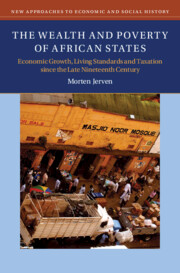Refine search
Actions for selected content:
26946 results in Economic history
Acknowledgments
-
- Book:
- The Wealth and Poverty of African States
- Published online:
- 06 January 2022
- Print publication:
- 13 January 2022, pp xv-xvi
-
- Chapter
- Export citation
Tables
-
- Book:
- The Wealth and Poverty of African States
- Published online:
- 06 January 2022
- Print publication:
- 13 January 2022, pp viii-x
-
- Chapter
- Export citation
1 - A New Economic History for Africa?
-
- Book:
- The Wealth and Poverty of African States
- Published online:
- 06 January 2022
- Print publication:
- 13 January 2022, pp 6-38
-
- Chapter
- Export citation
Introduction
-
- Book:
- The Wealth and Poverty of African States
- Published online:
- 06 January 2022
- Print publication:
- 13 January 2022, pp 1-5
-
- Chapter
- Export citation
Contents
-
- Book:
- The Wealth and Poverty of African States
- Published online:
- 06 January 2022
- Print publication:
- 13 January 2022, pp v-vi
-
- Chapter
- Export citation
3 - New Data and New Perspectives on Economic Growth in Africa
-
- Book:
- The Wealth and Poverty of African States
- Published online:
- 06 January 2022
- Print publication:
- 13 January 2022, pp 63-104
-
- Chapter
- Export citation
Figures
-
- Book:
- The Wealth and Poverty of African States
- Published online:
- 06 January 2022
- Print publication:
- 13 January 2022, pp vii-vii
-
- Chapter
- Export citation
6 - Conclusion
-
- Book:
- The Wealth and Poverty of African States
- Published online:
- 06 January 2022
- Print publication:
- 13 January 2022, pp 144-146
-
- Chapter
- Export citation
4 - State Capacity across the Twentieth Century: Evidence from Taxation
-
-
- Book:
- The Wealth and Poverty of African States
- Published online:
- 06 January 2022
- Print publication:
- 13 January 2022, pp 105-131
-
- Chapter
- Export citation
Copyright page
-
- Book:
- The Wealth and Poverty of African States
- Published online:
- 06 January 2022
- Print publication:
- 13 January 2022, pp iv-iv
-
- Chapter
- Export citation
Preface
-
- Book:
- The Wealth and Poverty of African States
- Published online:
- 06 January 2022
- Print publication:
- 13 January 2022, pp xi-xiv
-
- Chapter
- Export citation
5 - Wages and Poverty: From Roots of Poverty to Trajectories of Living Standards
-
- Book:
- The Wealth and Poverty of African States
- Published online:
- 06 January 2022
- Print publication:
- 13 January 2022, pp 132-143
-
- Chapter
- Export citation
Index
-
- Book:
- The Wealth and Poverty of African States
- Published online:
- 06 January 2022
- Print publication:
- 13 January 2022, pp 176-180
-
- Chapter
- Export citation
Pandemic recession and helicopter money: Venice, 1629–1631
-
- Journal:
- Financial History Review / Volume 28 / Issue 3 / December 2021
- Published online by Cambridge University Press:
- 11 January 2022, pp. 300-318
-
- Article
-
- You have access
- Open access
- HTML
- Export citation
The road to the 1980s write-downs of sovereign debt
-
- Journal:
- Financial History Review / Volume 28 / Issue 3 / December 2021
- Published online by Cambridge University Press:
- 11 January 2022, pp. 281-299
-
- Article
- Export citation

The Wealth and Poverty of African States
- Economic Growth, Living Standards and Taxation since the Late Nineteenth Century
-
- Published online:
- 06 January 2022
- Print publication:
- 13 January 2022
Reframing Chinese Business History
-
- Journal:
- Business History Review / Volume 96 / Issue 2 / Summer 2022
- Published online by Cambridge University Press:
- 14 December 2021, pp. 245-287
- Print publication:
- Summer 2022
-
- Article
- Export citation
Silver coins, wooden tallies and parchment rolls in Henry III's Exchequer
-
- Journal:
- Financial History Review / Volume 28 / Issue 3 / December 2021
- Published online by Cambridge University Press:
- 13 December 2021, pp. 364-382
-
- Article
- Export citation
Brewing a Boycott: How a Grassroots Coalition Fought Coors and Remade American Consumer Activism. By Allyson P. Brantley. Chapel Hill: University of North Carolina Press, 2021. 304 pp. Halftones, notes, bibliography, index. Paperback, $29.95. ISBN: 978-1-4696-6103-2.
-
- Journal:
- Business History Review / Volume 95 / Issue 4 / Winter 2021
- Published online by Cambridge University Press:
- 12 January 2022, pp. 869-871
- Print publication:
- Winter 2021
-
- Article
-
- You have access
- HTML
- Export citation
Des nations, des firmes et des montres: Histoire globale de l'industrie horlogère de 1850 à nos jours. By Pierre-Yves Donzé. Neuchâtel: Livreo Alphil, 2020. 248 pp. Tables, figures, appendix, bibliography. Paperback, $31.00. ISBN: 978-2-88950-044-4.
-
- Journal:
- Business History Review / Volume 95 / Issue 4 / Winter 2021
- Published online by Cambridge University Press:
- 12 January 2022, pp. 874-876
- Print publication:
- Winter 2021
-
- Article
-
- You have access
- HTML
- Export citation
